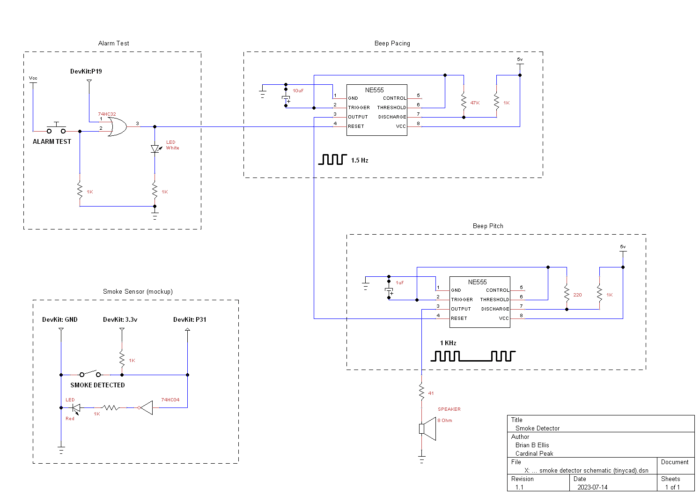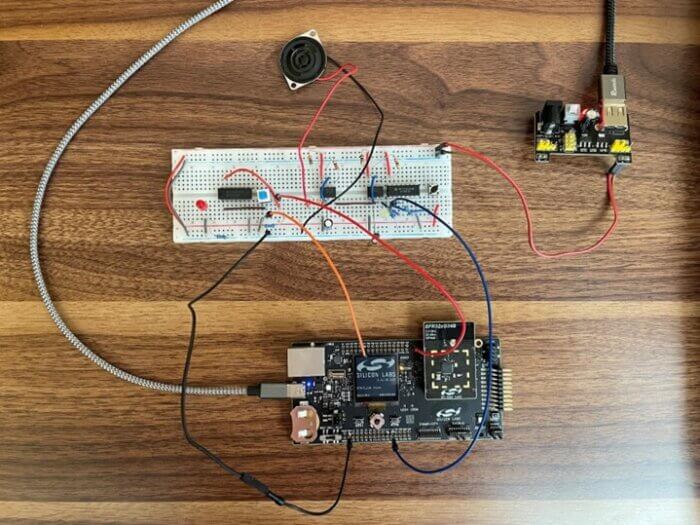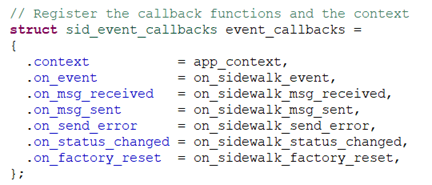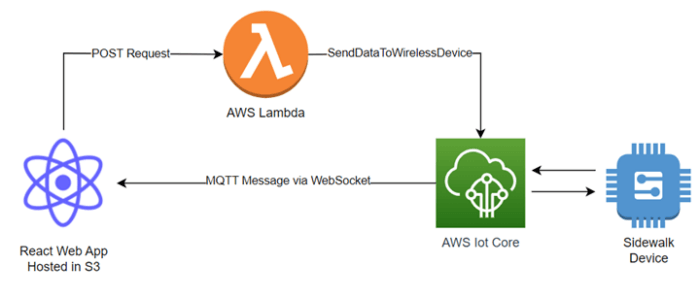Ever been caught off guard by a blaring smoke detector just because you slightly overcooked your dinner? We’ve all been there. But what if you could silence that alarm remotely? With Amazon Sidewalk devices — like a connected smart smoke detector — you can receive alerts on your phone when smoke is detected. Then, with just a tap, you can hush the alarm — no need to wave towels around or open your windows and doors.
As smart home and IoT technologies advance, integrating a smart smoke detector with the shared Amazon Sidewalk network offers five key value propositions within a broader smart home ecosystem:
- Extended range and accessibility.
- Gateway-free connectivity.
- Connectivity in remote/challenging areas.
- Cost-effective cloud data transmission.
- Diverse technological integration.
Since Amazon Sidewalk integration offers myriad benefits within a broader smart home ecosystem, we sought to prototype an Amazon Sidewalk-connected smart smoke detector. In this post, we’ll look at how we designed and built this proof of concept using the Sidewalk Dev Kit from our partner Silicon Labs.
Contents
The Amazon Sidewalk Device Smoke Detector Prototype
Amazon Sidewalk is a shared network that helps connected devices work better at home and beyond the front door by providing reliable connectivity. The unique shared network uses Bluetooth Low Energy, the 900 MHz spectrum and other frequencies to create a series of smaller mesh networks, ensuring devices stay connected further away from home — and even when Wi-Fi goes down.
Now accessible to 90-plus percent of the U.S. population, Amazon Sidewalk is relatively new, so we wanted to explore its potential by prototyping a simple but novel application. Our goal was to create a basic smoke detector that connects via the unique network and features the following elements:
- A simulated smoke sensor.
- An alarm buzzer.
- A web interface to view smoke alerts and silence the alarm.
However, a go-to-market product would likely include features like mobile app connectivity for real-time monitoring, customized alarm management, battery detection, device control, smart home integration, historical data and analytics, etc. Even as a simple proof-of-concept product, numerous smart home use cases exist where a smoke detector could provide value via the neighborhood-scale mesh network.
Wherever installed — a garage, back patio or basement with poor connectivity — an Amazon Sidewalk-connected detector could bridge that connection gap to transmit alerts. The user could then silence the alarm remotely rather than physically interacting with the detector in a dangerous, smoky environment.
While basic in functionality, this smart smoke detector prototype shows the new capabilities and conveniences that Amazon Sidewalk devices enable. Now, let’s look at how we built it.
Follow along with this accompanying video demonstrating the Amazon Sidewalk smoke detector prototype.
The Hardware: A Silicon Labs Sidewalk Dev Kit
The core of the prototype is the Sidewalk Dev Kit from Silicon Labs. This kit contains:
- A main board with a small screen, buttons and various interfaces. This board runs SILabs code not modifiable by developers.
- A daughter board that acts as the target hardware we program. There are two options:
-
- The EFR32xG24 board contains a Bluetooth Low Energy-only board with an EFR32 SoC.
- The KG100S board contains all three Amazon Sidewalk radios (BLE, FSK and CSS) using a Quectel module with an EFR32 inside.
We chose the BLE-only daughter board because it exposed some GPIO pins unavailable on the other board, allowing us to easily interface with our external hardware.
To simulate smoke detection and alarms, we built additional circuitry on a breadboard (see schematic below) with:
- A push button to trigger “smoke detected” signals.
- An LED indicator light.
- A 555 timer chip to drive an alarm circuit that beeps when enabled.
Amazon Sidewalk Smoke Detector Schematic

We connected the custom hardware to the dev kit using four connection wires:
- Ground (black).
- 3.3V power (red).
- Smoke detected output signal (orange).
- Alarm activate input signal (blue).
Breadboard Wired to Amazon Sidewalk Dev Kit

Determining which pins on the dev kit are available can take time and effort. After studying the device schematics, however, we were able to locate unused GPIO pins — P31 and P19 — for the input and output connections.
With the custom circuitry connected to the Sidewalk Dev Kit, our next step was developing the embedded and cloud software.
Our Amazon Sidewalk Device’s Embedded Software
For the embedded software, we could either start with a new “blank” project or leverage one of the SILabs Sidewalk demo projects and extend it. We opted to begin with the “Hello Neighbor” example project from SILabs, which already handles:
- Initializing the Amazon Sidewalk stack.
- Connecting to the Amazon Sidewalk network.
- An event loop to process messages/actions.
Events are generated (enqueued) from three sources:
1. Callbacks from the Amazon Sidewalk library:

2. Callbacks from the command-line interface (CLI):

3. Callbacks from button presses:

To receive the “smoke detected” signal from the breadboarded push button, we added the following functionality:
- Debouncing logic for the simulated smoke sensor push button input.
- Controlling the alarm buzzer based on Amazon Sidewalk commands.
- Amazon Sidewalk messaging to publish smoke alerts.
When the debounced input detects “smoke,” the smart detector fires a message over the Amazon Sidewalk network and turns on the alarm. When a “silence” command is received from the cloud, it turns off the alarm.
Complementing the smoke detector’s embedded logic, a web interface would enable remote alerts and online management. Check out how we built a user interface for remote monitoring and control.
The Web UI for Smart Smoke Detection
The cloud back end consists of a simple React web app that uses AWS IoT to connect via websockets and receive real-time Amazon Sidewalk device data.
Three possible states of the web UI exist:
- No smoke detected.
- Smoke detected.
- Silence alarm.
The web app also displays a visual smoke alarm indicator and allows users to silence the alarm by calling a Lambda function. The Lambda function uses the IoT Wireless API to send a message to the device over Amazon Sidewalk.
Interactions Between Web App, AWS Cloud Services and Sidewalk Device

By utilizing the example Amazon Sidewalk code from Silicon Labs and adding minor modifications, developers can prototype Amazon Sidewalk devices quickly on the software side.
Lessons for Future Amazon Sidewalk Device Development
Overall, creating the Amazon Sidewalk-connected smart smoke detector prototype was relatively easy. Even better, this prototyping project gave our team hands-on experience with the following:
- Interfacing real-world devices like sensors and alarms to the Silicon Labs Sidewalk Dev Kit.
- Modifying example Amazon Sidewalk device code for custom use cases.
- Building reactive UIs to display live data from devices.
- Using AWS IoT, Lambda and other services to manage devices in the cloud.
We found Sidewalk integration to be straightforward overall when using the BLE radio. Expanding to the other Sidewalk radios like FSK and CSS, on the other hand, would undoubtedly add more complexity. Even as a simple prototype, our prototype shows the potential for Amazon Sidewalk to connect devices where Wi-Fi is unreliable, enabling new smart home and smart city innovations.
As broadband networks advance and our connections grow more secure, Amazon Sidewalk and other networks like Z-Wave and Thread open the door to the next wave of connected device engineering.
While Sidewalk is still emerging, we’re excited to see innovative applications that utilize its unique mesh networking capabilities. At Cardinal Peak, we look forward to tinkering more with Amazon Sidewalk and seeing what the broader IoT community creates.
Do you have any questions about prototyping Amazon Sidewalk devices using the Silicon Labs dev kit and other tools? Let our team know you’re ready to get started with Amazon Sidewalk!
Learn about our Silicon Labs offshore development center.
